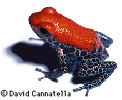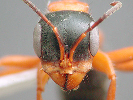Copyright Rules and Issues
Guidelines for Uploading Images, Text, Music, Movies and other Media, and Using them in Your Treehouse Page
- The Copyright Question: Wow! I found this image on the web (see below) and it would be perfect for my treehouse. Can I just upload this image to the ToL and use it in my page?
-
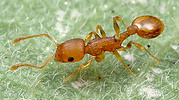 Temnothorax curvispinosus. U.S.A. (Kansas)
Temnothorax curvispinosus. U.S.A. (Kansas) - Answer: No! Almost all images on the web are copyrighted, even if they do not clearly list a copyright holder, and absolutely cannot be used unless you get permission in writing from the copyright holder. If you can't get permission you simply can't use the media file.
Please review this page before you upload media to the ToL database and begin your treehouse page. Take the Copyright Quiz when you are done.
- What is copyright?
- Will I keep the copyright to my work when I am a ToL contributor?
- What do I need to know about copyright to create Treehouse Pages?
- Giving credit
- Using ToL images and media in your treehouse projects
- Materials in the Public domain, Creative Commons and more
- Additional resource links
What is Copyright?
The books you read, the movies you watch and the songs you listen to have copyright owners. For example: Harry Potter and the Prisoner of Azkaban (the movie) © Copyright Warner Brothers; Lilo & Stitch © Copyright Walt Disney Studios; Into Wild Arizona, © Copyright 2004 by Blackbirch Press ™; The Lion the Witch and the Wardrobe, © Copyright C.S. Lewis Ptc. Ltd.
Anytime you create something original on your own, no matter how old you are, you become the copyright owner of your work. When you are the copyright owner it means that only you have the right to decide who can:
- make copies of your text, images, animations, audio, video, or web pages
- display or perform your work
- adapt or modify your work for their own use.
An image, video, sound or other media file doesn't need the word "Copyright" or the copyright symbol, © next to it or near it to be copyrighted. You don't have to register your work for it to be protected by copyright law. If the material is truly original, and nobody else can lay claim to it, it is protected as soon as you create it, and you can express this by marking it with a copyright symbol © and/or writing copyright next to your name: Copyright © 2004 Juanita Brown. Thus, when you see the symbol © or the word copyright, it tells you that someone owns the copyright to the material that you are looking at or listening to. Below see some examples of materials on the ToL and their copyright information.
When might somebody else lay claim to the copyright of your work? This could happen if your creation was based on some other piece of work that belonged to another copyright owner. For example if you draw a picture of Mickey Mouse, you may have trouble claiming copyright for it, because Mickey Mouse itself was created by somebody else, so it is not your own, original creation. If you are paid for creating something, the person who pays you may also be able to claim the copyright for your work. As discussed above, it is also often the case that if you publish your work the publisher will make you relinquish your copyright ownership.
Will I Keep the Copyright to My Work When I am a ToL Contributor?
Whenever you publish something on the Tree of Life you will keep the copyright for your work, and you will give the Tree of Life a license to display it. If you publish something in print or on the web, the publisher will often make you give up your copyright, so that you cannot publish your work anywhere else without their permission, but the Tree of Life does not do this.
What Do I Need to Know About Copyright to Upload Media to the ToL and Publish ToL Treehouses?
Uploading Media That You Did Not Create to the ToL Database
Whenever you upload and submit an image or other media file to the ToL database, we ask you for copyright and credits information. This copyright information will then be displayed wherever that media file is displayed on the ToL. When you add a media file to the ToL database, and then insert it into your treehouse page with the ToL Easy Editor, the copyright information will be printed automatically on the ToL page you are creating. If you choose not to use the ToL Easy Editor to add media to your page we must request that you type in the copyright information for the media file yourself. Additionally, If you use anything that has previously been published, please provide a reference for the source publication. See ToL Materials Copyright Information Display below for examples of the way copyright information is displayed on ToL pages.
- Copyrighted media
- The majority of images, sounds, and videos on the web and elsewhere are copyrighted, which means that you cannot upload them to the ToL unless you get permission in writing from the copyright holder
- Be very aware that an image, video, sound or other media file doesn't need the word "Copyright" or the copyright symbol, © next to it or near it to be copyrighted.You can paste a summary of the text of the permission note in the notes section of the media file or in the notes section of the Treehouse page (the latter is more useful if you have several images from the same copyright holder)..And it's simply not OK to just site where the media file is from. If you can't get permission you can still:
- Do a drawing based on some of the images you have seen, but make sure that it is not an exact copy or you need to obtain permission to reproduce the image. (see more information below).
- Explain the image/media file and link to the page that you found the media (but you cannot upload the media file to the ToL or use it on your pages).
- Public Domain Media Files
- We have a list of media files that are in the public domain. This means that they belong to be used and modified freely by anybody. If you find the image on one of the pages that we list, or you believe the media file is in the public domain, you must put the URL of the site where you obtained the file you say is in the public domain in the Credits - Acknowledgements section of the Image Data form
Publishing Media on ToL Pages
All media files on ToL pages must display copyright information (except for the few that are in the public domain). When you insert a media file into a Treehouse page using the ToL Easy Editor, images will will automatically be displayed with the copyright information beneath them. Do not delete this information. If you add media without the Easy Editor you will need to type in the copyright information.
Using Text from Other Places in Your Page
Grabbing the entire text from another web page and putting it into your treehouse is not acceptable. If you want to use the entire text of a page you should link to that page. However, it is perfectly acceptable to use some text from other web pages or other sources and long as you put the reference in the References section of your page.
The Benefits of Respecting Other People's Copyright
It may seem like a bit of a pain to see a nice picture and not be able to just copy it and use it. But the rule is simply that if a work has a copyright owner and it is not explicitly stated that you can use that work for publishing on the WWW for education purposes, you must ask permission before you use the material on your ToL page. Tracking down the copyright owner and asking for permission takes time and effort, and sometimes you may get a negative response or no response at all. However, respecting other people's copyright is an essential part of being a competent web page author and multimedia developer.
By pooling your resources and creativity with others, you have the opportunity to produce materials that are of better quality and more attractive than anything you could have created on your own. It is therefore important that you treat the work of other creative people with the same respect that you expect for your own contributions. In a community of multimedia developers, participation in creative collaborations should be voluntary. Therefore, you not only need to credit all contributors, but you should also make sure that they are willing to have their work featured in the context of your contribution.
Using ToL Images and Media in Your Treehouse Projects
There are hundreds of quality media files in the ToL database that are available for use in your treehouse page. When you are editing your page you can search for them by clicking on the add image or add media buttons in the ToL Easy Editor. If media files from copyright owners are marked as available, you may insert them into your treehouse page. For example, The Life as a Lizard Treehouse game combines materials from different copyright owners who are ToL contributors. The search from within the Easy Editor will only find images and media you are allowed to use in your treehouse. You can also search for images using the ToL advanced image search but this search will find both images that you are allowed to use and images that are restricted and that you cannot use in your treehouse (the treehouse editor won't let you insert restricted images). Browse the tables below to learn more about media use choices that ToL contributors can indicate, as well as how copyright is presented in ToL pages.
Copyright information is printed alongside all materials displayed on the ToL web site. See examples below.
Contributors to the ToL keep the copyright for:
- the text and page design of treehouses they contribute
- media they have created and contributed to the Tree of Life database.
In order to make combining creative efforts with others fairly easy within the context of the Tree of Life project, ToL contributors must specify the conditions of use for their materials. Specifying the conditions of use make it very clear to ToL contributors what they can do with others' work. When you add media or treehouses to the ToL, you are asked to select one of three models (see the table below) that grant the ToL non-exclusive rights of use.
| ToL Use Models | Use of ToL Media in Treehouses |
|---|---|
| 1. Restricted to one-time use in specified location. Do not edit.
This option is for Treehouse Builders who want to maintain strict control over the use of their materials. Content submitted under this model is provided only for specific use on a particular ToL page. While these materials may be featured in the results of ToL search facilities, they are not available for any other use without prior consultation with the copyright owner. |
When a material is ToL Use, restricted:You can't use images, media, audio etc. on your ToL treehouse page unless you obtain permission from the copyright owner. When you search for media to put in your treehouse from within the treehouse editing form, you will not be able to find media that are set to ToL Use: Restricted. However, you can find restricted images in a ToL image search. |
2. Use anywhere on the Tree of Life. Choose to allow minor modification only or allow for modification. Contributions submitted under this model can be used by other ToL contributors to put together multi-authored ToL pages about a given topic. For example, a contributor may submit a description of the mating behavior of a dragonfly; another contributor writing a page about mating behavior in insects may then want to feature this description (in whole or in part) as an example on their own page. Whenever a contributor's contribution is displayed on a ToL page, it will be credited to the original author, and there will be a copyright notice informing visitors that the material is protected by copyright law. | When a material is ToL Use, anywhere on the ToL:You may use an image, audio file, movie, or treehouse text and page design in your treehouse page as long as you credit the copyright owner.
|
| 3. Unrestricted ToL use and share with other scientific/educational projects. Choose to allow minor modification only or allow for modification.
This model covers all ToL use detailed in model 2. In addition, it allows the ToL to share materials with select, non-commercial, scientific or educational partner projects. Media submitted under this model may be exported to the databases of ToL partner projects, and they may be displayed on the web sites of these projects. Note that the ToL does not share materials with commercial content providers. Also, the ToL requires collaborating projects to always credit copyright owners alongside materials imported from the ToL collection. We encourage ToL contributors to choose this model in order to maximize the dissemination of their materials through not-for-profit projects, and to participate to the fullest in an emerging, international community of scientific and educational content providers. | When a material is ToL Use, share with ToL partners:You may use an image, audio file, movie, or treehouse text and page design in your treehouse page as long as you credit the copyright owner.
|
ToL Materials Copyright Information Display
All media files and pages on the ToL must display copyright information.
Copyright of ToL Pages
If you are the Copyright owner of a ToL page it means that you own the copyright of the text and page design.
For example, at the bottom of the Bembidion branch page is printed, Page Copyright 2004 © David R. Maddison. This tells you that David R. Maddison is the copyright owner of the page's text and overall page design.
Copyright of ToL Images
The images show below are both from the Life as a Lizard Treehouse.
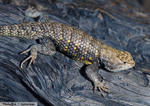
Image copyright © A.T. Holycross. Sceloporus magister (Desert Spiny Lizard).
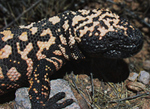
Image copyright © 2003 Tom Brennan. Heloderma suspectum (Gila Monster), Pima County, AZ.
Copyright of ToL Media Files
Media files (movies, documents, and audio) do not have the copyright owner printed beneath them, rather you need to click on the link to view or listen to that file in order to see the copyright information.
Materials in the Public Domain, Creative Commons and More
Materials in the public domain.
Certain materials are considered to be in the public domain. This means that they belong to everybody and can be used and modified freely by anybody. There are many reasons why a work may be in the public domain. Any copyright owner is free to release his or her work into the public domain at any time. Many works published by the US government are in the public domain, and many things that were published a long time ago have passed into the public domain because their copyright has expired. Deciding whether an individual resource is in the public domain can sometimes be tricky, so unless a resource is clearly marked as public domain, you should not assume that it is freely available. Also, even if something is in the public domain, you should still cite the person who created it and/or the source that provided it. We have compiled a list of web sites that provide public domain images and other media about organisms.
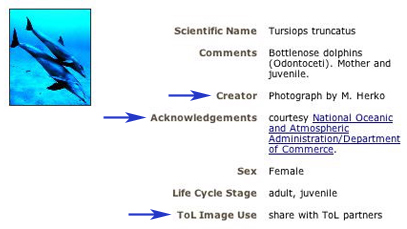
When a contributor marks a material as in the public domain a copyright owner is not displayed. When you contribute material that is the public domain, you should acknowledge the source of the image and the creator by filling out the credits fields in the image/media data entry form. Then assign public domain images ToL use: Share with ToL partners, modification permitted.
Web sites that provide copyright-protected materials about organisms freely for online educational or scientific use
There are also many web sites that provide copyright-protected materials about organisms freely for online educational or scientific use. If you copy something from a site that has this kind of use policy clearly stated, you do not generally have to ask them for permission to include their materials on your ToL treehouse contributions. Treehouses definitely qualify as educational, scientific, or not-for-profit use. Some sites may request that you let them know when you use their resources. If this is the case, you should send them an e-mail telling them exactly what you have used (e.g., provide the url of the web page featuring a copied image and the url of the copied image) and giving them the url of your treehouse contribution.
Creative Commons
Many copyright owners now release their work under what is called a Creative Commons license. With a Creative Commons license, you keep your copyright but allow people to copy and distribute your work provided they give you credit, and follow the conditions you specify. There are many different types of Creative Commons licenses. The most important distinction between the types of CC licenses is that some allow for derivative work (e.g. using the image etc. and modifying it) while others do not. For example, if you see that the copyright owner has released this image under the Attribution-NonCommercial-NoDerivs 2.0 Creative Commons license you can't use it within a video you are creating, however you could use it in a web page. This is because in the video you would be creating a derivative work, and in the web page you would just be using the image in it's original form. Flickr's Creative Commons page is an excellent place to find images. If you find an image or other media file that has a Creative Commons licence and you want to add it to the ToL image library you need to do two things:
- Indicate which creative commons license the media file is licensed under in the acknowledgements section (soon we will automate this). Note that if it is under a no-derivative license you can't use it in a video.
- Provide a link to the page you found the image.
Additional Resource Links
Copyright Kids has some really fun stuff for kids to learn more about copyright. They include a section on how to ask permission to use other people's work with sample permission letters and lists of publisher's contact information. They also have a definitions page and a fantastic interactive activity about students building a multimedia yearbook and the copyright issues they come across.
Copyright Questions and Answers and The Copyright Website are also very helpful sites.
Guidelines for educational use of multimedia are constantly developing alongside new uses of technology. For more detailed information see The Fair Use Guidelines For Educational Multimedia and Georgia Harper's Crash Course in Copyright.
What is copyright? Print a copy of copyright basics (2 pages) Take the Copyright Quiz read more.. go to top go to top go to top top Go to quick links
Go to quick search
Go to navigation for this section of the ToL site
Go to detailed links for the ToL site
Go to quick links
Go to quick search
Go to navigation for this section of the ToL site
Go to detailed links for the ToL site
